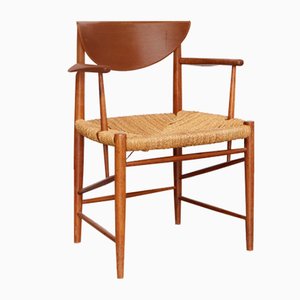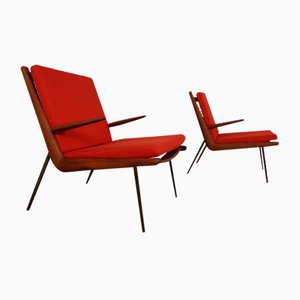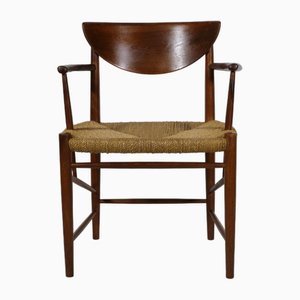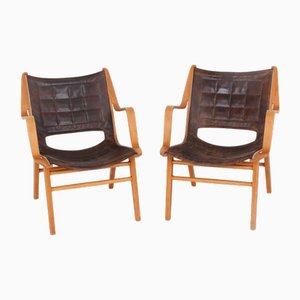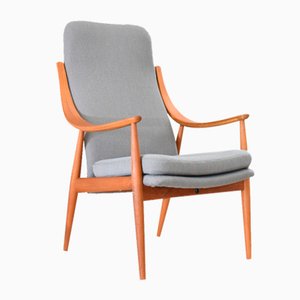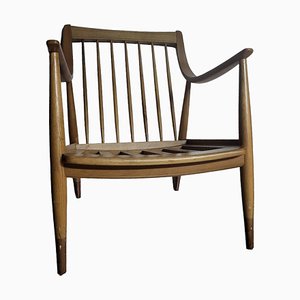
Hvidt & Mølgaard was a Copenhagen-based, Danish design and architectural firm which existed from 1944 until 2009. Founded by Peter Hvidt (1916-1986) and Orla Mølgaard-Nielsen (1907-1993), the company was a pioneering force in Danish furniture design and industrialized production in the 1950s, creating furniture that was easy to mass-produce and economic to transport.
Danish architect-designer Orla Mølgaard-Nielsen was born in 1907. His formative years were spent in Copenhagen, studying at the Aalborg Technical School (graduating in 1924) and at the Art and Crafts School of the Design Museum (graduating in 1928). From 1931 until 1934, he continued his studies in furniture design at the Royal Danish Academy of Fine Arts under the instruction of Danish master Kaare Klint (1888-1954).
Danish architect-designer Peter Hvidt was born in Copenhagen in 1916. He studied architecture and cabinetry at the School of Arts and Crafts in Copenhagen. Subsequently, he worked at various design firms before establishing his own studio in 1942. From 1942 to 1945, Hvidt taught at the School of Arts and Crafts. In 1944, Hvidt designed the Portex Chair, which was one of Denmark’s first stacking chairs. Hvidt, whose design aesthetic was characterized as traditional throughout the 1940s, exhibited frequently at the Cabinetmaker's Guild exhibitions, as both a designer and architect. He also worked with the lighting manufacturer Le Klint on numerous lighting designs.
In 1944, the pair co-established Hvidt & Mølgaard Studio, which they ran together until 1975. During this time, the pair created designs for Fritz Hansen, France & Søn, and Søborg Møbelfabrik. In 1950, the pair designed the AX Chair, which solidified both of their careers as industrial designers and became an icon of Danish mid-century design. AX was inspired by the work of American design duo Charles and Ray Eames, and was the first Danish chair that was crafted with both a seat and back made of curved laminated wood. The chair utilized a laminated technique for production which was carried out by Fritz Hansen. The chair’s design allowed for mass production and easy packaging, opening a successful market for Danish furniture to be exported around the world. The AX Chair was eventually accompanied by the AX Table, which was exhibited in 1951 as part of the "Good Design" show sponsored by the Museum of Modern Art in New York. Like many designers of the mid-century period, they also incorporated leather in their designs, as well as teak and cane, and created modular units such as bookcases and living room sets. Other designs by the pair include the FD134 Chair, FD145 Chair, Gateleg Dining Table, Minerva Sofa, and the Model 523—or Pinwheel—side table (all 1950s for France & Søn).
Hvidt & Mølgaard focused on architectural projects, which spanned office buildings and factories, such as the De Danske Sukkerfabrikker building in Copenhagen (1958), as well as collective housing projects in Søllerød, Hillerød, and Birkerød (1962–1970). They were known for their light, simple, and clear designs, which were carried out with precision. In 1970, Hans Kristensen (b. 1933) joined the firm, helping the pair to design the Little Belt Bridge (1965-1970) and the Vejle Fjord Bridge (1975- 1980).
Both Hvidt and Mølgaard-Nielsen retired in 1975, designing over 256 pieces of furniture together over the course of their careers. Hvidt passed away in 1986 and Mølgaard-Nielsen in 1993. Hvidt received the Diplôme d'Honneur at Milan’s Triennale in 1951 and 1954. Mølgaard-Nielsen was jointly awarded an iF Product Design Award for the Safari lamp for Nordisk Solar Compagni (1981, Christian Hvidt, Peter Hvidt & Orla Mølgaard-Nielsen). Their work can be found at New York’s MoMA, the National Gallery in Melbourne, and the Danish Museum of Art & Design in Copenhagen.
The company continued to thrive after the founders' retirement, and was run by Kristensen, Peter Holsøe (b. 1943), and Hvidt's son Henrik Hvidt (b. 1945). Later architectural works include, buildings for Nokia (1996) and DONG in Copenhagen’s South Docklands, and two masterplans for major harbor redevelopments in Estonia. In 2009, the company was split in two, forming Hvidt Arkitekter and Holsøe Arkitekter.

